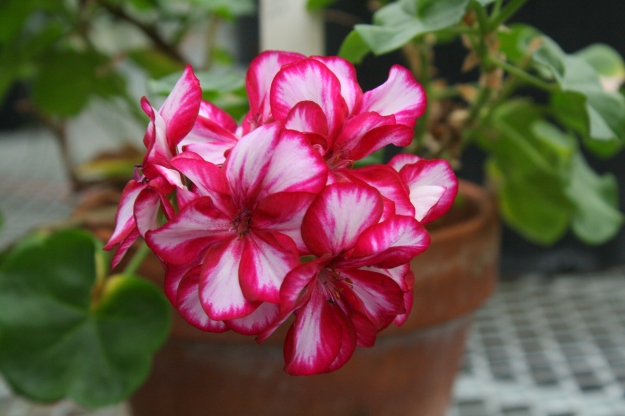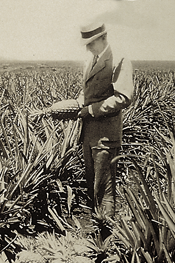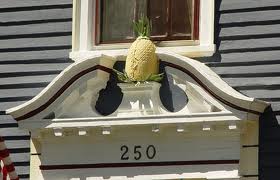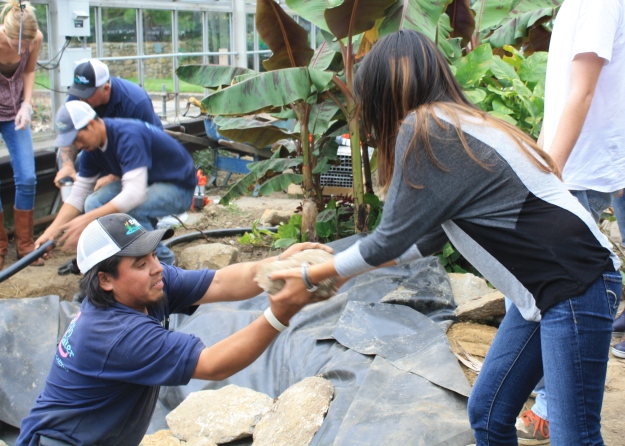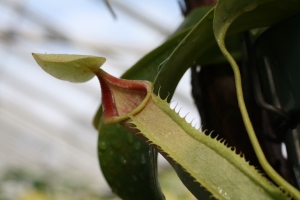Tag Archives: tropical plants
A Beautiful Bromeliad
Ananas comosus, the pineapple, is a plant that grows well in the greenhouse. Over the past few years we have successfully grown pineapple fruits along with our other Bromeliad family plants. There are so many fun facts to share with you about pineapples that I hardly know where to begin!
Native to southern Brazil and Paraguay, where its wild relatives occur, the pineapple was apparently domesticated by the indigenous people there and carried by them up through South and Central America to Mexico and the West Indies long before the arrival of Europeans. The first European account of the pineapple was given by Christopher Columbus and his company, who landed on the island now known as Guadeloupe on their second voyage of discovery. Columbus brought the succulent fruit back to Europe in 1493. Its cylindrical shape and rough, spiky surface caused the Spaniards to name it pina, after the pine cone. The English noted the same resemblance, resulting in our name “pineapple”.
Over the centuries, explorers carried pineapples and pineapple plants all over the world. They thrived in many tropical climates, perhaps most famously in Hawaii. Captain John Kidwell is most often credited with founding Hawaii’s pineapple industry. He began crop development trials in 1885 when he planted pineapple on the island of Oahu. It was, however, James Drummond Dole who is remembered for advancing the industry in Hawaii. In 1900 Dole purchased 61 acres in Oahu and began experimenting with pineapple. He incorporated the Hawaiian Pineapple Company in 1901 and began commercial growing. Dole was known as Hawaii’s “Pineapple King”, and the brand name Dole is synonymous with pineapple. But today, Hawaii’s pineapple production does not even rank within the top ten of the world’s pineapple producers. Worldwide, the top producers are Thailand (13%), the Philippines (11%) and Brazil (10%). Hawaii produces only about two percent of the world’s pineapple.
Ananas comosus is a tropical plant limited (except in greenhouses) to low elevations between 30°N and 25°S. A temperature range of 65°- 95°F is most favorable. Ideal rainfall is about 45 inches per year, half in the spring and half in the fall; though the pineapple is drought tolerant and will produce fruit under yearly precipitation rates ranging from 25 to 150(!) inches, depending on cultivar and location. They will grow well in full sun to light partial shade. The best soil for pineapple culture is a rich, well-drained, sandy loam. In the greenhouse they grow well in potting soil but do not like to be overwatered!
 A herbaceous perennial, the pineapple grows 3.5 to 5.0 ft tall. It produces many flowers at once, up to 200 at a time. Once it flowers, the individual fruits of the flowers join together to create a cone-shaped, compound, juicy, fleshy fruit — the pineapple. They can be propagated by planting the “crown” (the leafy top) of the fruit, or by planting the suckers which emerge from the sides and roots of the plant.
A herbaceous perennial, the pineapple grows 3.5 to 5.0 ft tall. It produces many flowers at once, up to 200 at a time. Once it flowers, the individual fruits of the flowers join together to create a cone-shaped, compound, juicy, fleshy fruit — the pineapple. They can be propagated by planting the “crown” (the leafy top) of the fruit, or by planting the suckers which emerge from the sides and roots of the plant.
To the Carib native people, the pineapple symbolized hospitality, and the Spaniards soon learned they were welcome if a pineapple was placed by the entrance to a village. This symbolism of hospitality spread to Europe and eventually through colonial North America. The English colonies on the East Coast were a land of small, primitive towns and settlements where homes served as the hubs of most community activity. Visiting was the primary means of entertainment and information exchange. The concept of hospitality was a central element of the society’s daily life. Seafaring captains used to impale fresh pineapples–souvenirs of their travels to tropical ports–atop the porch railings of their homes when they returned. It was a sign that the captain and his family were home and would welcome visitors.
This symbol of friendship and hospitality also became a favorite motif of architects, artisans and craftsmen throughout the colonies.The pineapple was seen painted on the front doors of homes, carved in finials atop gate-posts, entrance and porch columns, roof-tops, door lintels, bedposts and head-boards. Copper and brass pineapples were prominent in the weather vanes of public buildings. Pineapples were stenciled on walls and canvas mats. There were pineapples carved of wood, painted on fine china, and painted on the backs of chairs and tops of chests. Colonial needle-workers used the pineapple image for cross-stitch samplers, tablecloths, napkins, carpets, draperies, and crochet doilies.
If you visit the greenhouse, you will see a dwarf ornamental pineapple is just inside the Conservatory door to welcome you! Amid the food crop plants in greenhouse 113 and 111 you’ll find our full size plants with fruit. Although the flavor is not the same as pineapples grown outside in tropical fresh air and sunshine, the fragrance is incomparable! It fills the greenhouse as they ripen and makes my mouth water.
Featured Plant: Poinsettia
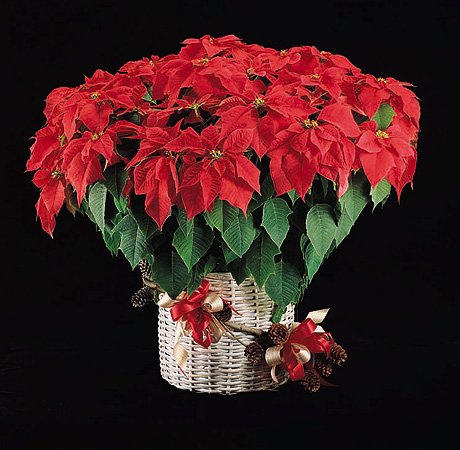 (So many questions about poinsettias at this time of year! Here’s a “Featured Plant” post about these lovely holiday plants, from 2012. See you in 2015!)
(So many questions about poinsettias at this time of year! Here’s a “Featured Plant” post about these lovely holiday plants, from 2012. See you in 2015!)
December 12th is officially Poinsettia Day! These beautiful plants that we associate with the Christmas season have a fascinating history. They are native to the warm climate of Southern Mexico. They are found in the wild in deciduous tropical forest at moderate elevations down the entire Pacific coast of Mexico from Sinaloa to Chiapas and into Guatemala. They are also found in the interior of Mexico in the hot, seasonally dry forests of Guerrero and Oxaca. Although they are Euphorbias (Spurge Family), and were originally named Euphorbia pulcherrima, they were renamed Poinsettia pulcherrima to honor Joel Roberts Poinsett.
 Poinsett was the first American ambassador to Mexico, and was very interested in botany. He often wandered the countryside looking for new and interesting plants. In 1828, as he was traveling through the Taxco region of the new Republic of Mexico, he saw a beautiful shrub with large red flowers and took cuttings, which he brought back to the greenhouse at his South Carolina home.
Poinsett was the first American ambassador to Mexico, and was very interested in botany. He often wandered the countryside looking for new and interesting plants. In 1828, as he was traveling through the Taxco region of the new Republic of Mexico, he saw a beautiful shrub with large red flowers and took cuttings, which he brought back to the greenhouse at his South Carolina home.
The modern American Poinsettia “industry” was created almost single-handedly by the Ecke family of California at the turn of the last century. This is a great American immigrant success story! From the website Poinsettiaday.com:
“Originally from Germany, Albert Ecke emigrated to the U.S, in 1906 and settled in the Hollywood area. The family lived off the land growing fruits and vegetables but were also, by 1909, selling cut Poinsettias at a stand on Sunset Boulevard. Poinsettias grew wild in the area and son Paul Ecke (Paul Sr.) had the idea that the ruby flowers would sell well around Christmas. This turned out to be so successful that in 1915 Albert Ecke bought five acres in nearby El Monte to grow poinsettias. By 1917 the Eckes were shipping plants to customers in New York and Chicago. When Albert died in 1919, Paul Sr. took over the flower business and though the family prospered, by 1923 the pressures of a rapidly urbanizing Hollywood led Paul Sr. to move the operation to 40 acres in Encinitas.
In 1955 Paul Ecke Jr. returned with a degree in floriculture from Ohio State with ideas of his own about how to move forward with the family business. It took some doing but eventually he as able to convince Paul Sr. to move the growing out of the fields and into greenhouses. Paul Jr and the Ecke family had a secret technique that caused every seedling to branch, resulting in a fuller plant. Paul Jr. also took a very active role in marketing poinsettias, making them visible on television programs such as The Tonight Show, the Dinah Shore Show, and Bob Hope’s Christmas Special. He also had them displayed in women’s magazines like The Ladies Home Journal and Better Homes & Gardens. By the time of his death in 2002, poinsettias were the number one selling potted plant in America, in part to his tireless promotional efforts.
Here are a few more Poinsettia facts:
- The Aztecs called them “Cuitlaxochitl”. Montezuma, the last Aztec emperor, had them brought by carts to adorn his city (what is now Mexico City).
- What look like the petals of flowers on the Poinsettia are actually bracts (modified leaves) and the flowers are only the small yellow centers.
- Poinsettias are NOT poisonous!
- Poinsettias are the best selling potted plant in the United States and Canada and contribute over $250 million to the US economy at the retail level.
On a long-ago trip to San Francisco at New Years, I remember wandering through the back streets of that beautiful city and seeing Poinsettias growing as huge shrubs in tiny urban yards and gardens. It was the first time I had ever seen a tropical plant growing in an outdoor environment.
If you are interested in keeping your holiday poinsettia as a year round house plant and having it bloom again, the University of Illinois has a great website giving details of Poinsettia culture: The Poinsettia Pages.
I Can’t Stand Long Goodbyes
But that’s what you get with a Titan Arum. Audrey began to wilt a little bit by the afternoon of September 2nd. The next morning, she was standing tall again but the edge of the spathe remained slightly wilted. Visitors to the greenhouse both days were thrilled however, to see our beautiful, rare, and fleeting blossom. Pictures of the crowds are being held hostage by a corrupted memory card in my camera, but I hope to liberate them soon!
Over the next week or two, Audrey will further close and wilt, until the prehistoric-looking flower is just a memory. When the stalk is completely dead, it gets cut it back. The corm will be repotted into the biggest pot I can find, and then go through it’s dormant period in a dry place (not the greenhouse). About 6 months from now, we’ll expect to see a “spike” — most likely a leaf — pushing up through the soil, and the pot will be returned to the greenhouse to go through the next part of it’s life cycle.
Here’s a link to the time lapse video made by Randy Stevenson of URI New Media. It highlights the two days of Audrey’s bloom. I love the part where the sun comes up and shines in through the greenhouse. Thanks Randy!
http://youtu.be/d-je5k5t8V4?hd=1
Still July
Still July. Color and heat are the themes in the Garden. Lilies, inherited from the Biological Control Lab Lily Leaf Beetle program here at URI ( http://cels.uri.edu/pls/biocontrol/ ), hold up really well in the heat.
Watering is crucial in some spots, but most of the Garden survives, even thrives, without extra watering. The dahlias donated by the Rhode Island Dahlia Society are taking off. They may be small this year but next year they will be incredible, I promise!
 A large hole in the sunny border (“Let’s call it an alteration rather than destruction”–thanks, Louis) is the result of a frantic search for a dropped engagement ring. All’s well that ends well, I guess! In the Conservatory, the temps are warm and tropical, amazing flowers are blooming and papayas are slowly ripening.
A large hole in the sunny border (“Let’s call it an alteration rather than destruction”–thanks, Louis) is the result of a frantic search for a dropped engagement ring. All’s well that ends well, I guess! In the Conservatory, the temps are warm and tropical, amazing flowers are blooming and papayas are slowly ripening.
The pumpkin vines in the All – America Selections Garden are growing about a foot a day. Even the melons, which were dreadful last year, are looking good. A woodchuck has tunneled into the lower AAS Garden and eaten the ornamental kale. I am plotting my revenge.

 Black-eyed Susans (Rudbeckia spp.) are everywhere, blooming almost a full month earlier than last year.
Black-eyed Susans (Rudbeckia spp.) are everywhere, blooming almost a full month earlier than last year.
In the Greenhouse, Part Two
Change is Good, continued…
 The Horridge Conservatory has a new, bigger, better, and very beautiful water garden, thanks to students of PLS 306, Landscape Management and Arboriculture.The Conservatory greenhouse has been in a state of “organized disarray” since July, when everything was pulled out for the reglazing work, including the existing water garden.
The Horridge Conservatory has a new, bigger, better, and very beautiful water garden, thanks to students of PLS 306, Landscape Management and Arboriculture.The Conservatory greenhouse has been in a state of “organized disarray” since July, when everything was pulled out for the reglazing work, including the existing water garden.
 With a generous donation of their time, Earth and Water Landscapes owner Joe Mack and two of his employees walked the class through the steps of installing an environmentally friendly water garden. Everybody pitched in as Joe explained the “whys” of a successful water garden — one with sparkling clear water, beautiful plants, and healthy fish.
With a generous donation of their time, Earth and Water Landscapes owner Joe Mack and two of his employees walked the class through the steps of installing an environmentally friendly water garden. Everybody pitched in as Joe explained the “whys” of a successful water garden — one with sparkling clear water, beautiful plants, and healthy fish.

 I’m looking forward to the rest of the Conservatory renovation, which will include not only the water garden, but a desert plant area, a tropical planting, and a large display of economically important plants, from coffee to cotton!
I’m looking forward to the rest of the Conservatory renovation, which will include not only the water garden, but a desert plant area, a tropical planting, and a large display of economically important plants, from coffee to cotton!
Change is Good, Part Two
Creatures from the Black Lagoon
Not the Gill-Man, but almost as strange: Carnivorous Plants.
The Horridge Conservatory features a Bog Garden with a unique collection of carnivorous plants. These plants have the specialized ability to trap and digest invertebrates of various kinds, mostly insects ( although some large tropical specimens are said to be capable of digesting frogs, mice, rats, and bats….) These insect-eating beauties evolved in environments where nutrient concentrations are low but water and sunshine are seasonally abundant, such as bogs and swamps.
There are different mechanisms for insect-trapping if you’re a plant. One, used by the Pitcher Plants, is to have a chamber full of enticing liquid for the poor bug to drown in and then be digested. Another is to have glandular hairs on stalks with very sticky droplets on them. The Sundews use this method to capture their prey, which is then digested when the glands produce digestive enzymes. A third method is used by Venus Fly Traps, which is possibly most like the Creature: Near the crease where the two leaf “jaws” join there is a series of tiny hairs. If an insect walks across these hairs, touching two or more of them in succession, the leaf will close quickly enough to prevent its escape. The insect is then slowly digested and absorbed by the leaf.
The Bog Garden has both native and exotic carnivorous plants. There are Sarracenias, Pitcher Plants that are native to the Southeastern US, along with many beautiful hybrid Sarracenias, in different colors and sizes. There are also Nepenthes, the tropical Pitcher Plants. Some of these are on loan from a student here at URI — thanks, CJ! There are Butterworts (Pinguicula species), which trap insects with sticky hairs along the leaves and s-l-o-o-o-w-l-y roll the leaf around the insect and digest it. The Venus Fly Trap, Dionaea muscipula, is the only species of its genus and native to the Southeastern US. It continually flowers and re-seeds in the Bog.
Some of the carnivorous plants are easy to grow and make interesting houseplants! Yes, you can feed them insects, but it is better not to trigger trapping mechanisms, unless you actually have food for them. Otherwise, they are expending a huge amount of physiological energy for no gain, and that will weaken them.
I enjoy observing the carnivorous plants even when they are not dining. Their unusual forms are intriguing and make them a great subject for photos and drawings. In fact, there are some beautiful botanical drawings of Pitcher Plants in our Hallway Gallery. For more information, the New England Carnivorous Plant Society, which generously donated many plants to the Conservatory Bog, has a great informative website, http://www.necps.org, AND a Carnivorous Plant Show in the fall. Happy Hunting!

